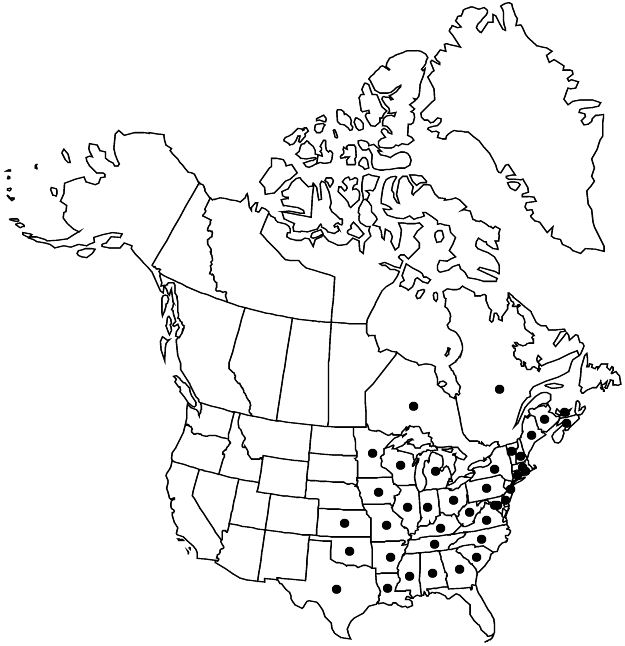Difference between revisions of "Viola sagittata"
Hort. Kew. 3: 287. 1789.
FNA>Volume Importer |
imported>Volume Importer |
||
| Line 23: | Line 23: | ||
-->{{Treatment/Body | -->{{Treatment/Body | ||
| − | |distribution= | + | |distribution=N.B.;N.S.;Ont.;P.E.I.;Que.;Ala.;Ark.;Conn.;D.C.;Del.;Ga.;Ill.;Ind.;Iowa;Kans.;Ky.;La.;Maine;Mass.;Md.;Mich.;Minn.;Miss.;Mo.;N.C.;N.H.;N.J.;N.Y.;Ohio;Okla.;Pa.;R.I.;S.C.;Tenn.;Tex.;Va.;Vt.;W.Va.;Wis. |
|discussion=<p>Varieties 2 (2 in the flora).</p> | |discussion=<p>Varieties 2 (2 in the flora).</p> | ||
|tables= | |tables= | ||
| Line 53: | Line 53: | ||
|basionyms= | |basionyms= | ||
|family=Violaceae | |family=Violaceae | ||
| − | |distribution= | + | |distribution=N.B.;N.S.;Ont.;P.E.I.;Que.;Ala.;Ark.;Conn.;D.C.;Del.;Ga.;Ill.;Ind.;Iowa;Kans.;Ky.;La.;Maine;Mass.;Md.;Mich.;Minn.;Miss.;Mo.;N.C.;N.H.;N.J.;N.Y.;Ohio;Okla.;Pa.;R.I.;S.C.;Tenn.;Tex.;Va.;Vt.;W.Va.;Wis. |
|reference=None | |reference=None | ||
|publication title=Hort. Kew. | |publication title=Hort. Kew. | ||
|publication year=1789 | |publication year=1789 | ||
|special status=Endemic | |special status=Endemic | ||
| − | |source xml=https:// | + | |source xml=https://bibilujan@bitbucket.org/aafc-mbb/fna-data-curation.git/src/bb6b7e3a7de7d3b7888a1ad48c7fd8f5c722d8d6/coarse_grained_fna_xml/V6/V6_277.xml |
|genus=Viola | |genus=Viola | ||
|species=Viola sagittata | |species=Viola sagittata | ||
Revision as of 23:38, 27 May 2020
Plants perennial, acaulescent, not stoloniferous, 5–50 cm; rhizome thick, fleshy. Leaves basal, 4–8, ascending to erect; stipules linear-lanceolate, margins entire, apex acute; petiole 2–13 cm, glabrous or pubescent; middle and lateral blade lobes differ in width and/or shape, earliest blades ovate to elliptic, mid-season blades ovate, elliptic, narrowly elliptic to narrowly deltate, 1–8 × 1–5 cm, incised or lobed at base only, base sagittate or hastate, truncate, attenuate, or ± cordate, margins crenate or serrate, ciliate or eciliate, apex acute, surfaces glabrous or pubescent. Peduncles 3–15 cm, glabrous or pubescent. Flowers: sepals lanceolate to ovate, margins ciliate or eciliate, auricles 2–3 mm; petals light to dark violet on both surfaces, lower 3 white basally, lowest dark violet-veined, lateral 2 densely bearded, spur on lowest petal occasionally bearded, lowest 10–15 mm, spur light to dark violet, gibbous, 2–3 mm; style head beardless; cleistogamous flowers on prostrate, ascending, or erect peduncles. Capsules ellipsoid, 10–14 mm, glabrous. Seeds beige, mottled to bronze, 1.3–2.5 mm.
Distribution

N.B., N.S., Ont., P.E.I., Que., Ala., Ark., Conn., D.C., Del., Ga., Ill., Ind., Iowa, Kans., Ky., La., Maine, Mass., Md., Mich., Minn., Miss., Mo., N.C., N.H., N.J., N.Y., Ohio, Okla., Pa., R.I., S.C., Tenn., Tex., Va., Vt., W.Va., Wis.
Discussion
Varieties 2 (2 in the flora).
Selected References
None.
Key
| 1 | Mid-season leaf blades: base sagittate, hastate, or ± cordate, surfaces glabrous or sparsely pubescent; sepal margins eciliate. | Viola sagittata var. sagittata |
| 1 | Mid-season leaf blades: base truncate, attenuate, slightly sagittate or hastate, or ± cordate, surfaces usually densely pubescent; sepal margins ciliate. | Viola sagittata var. ovata |